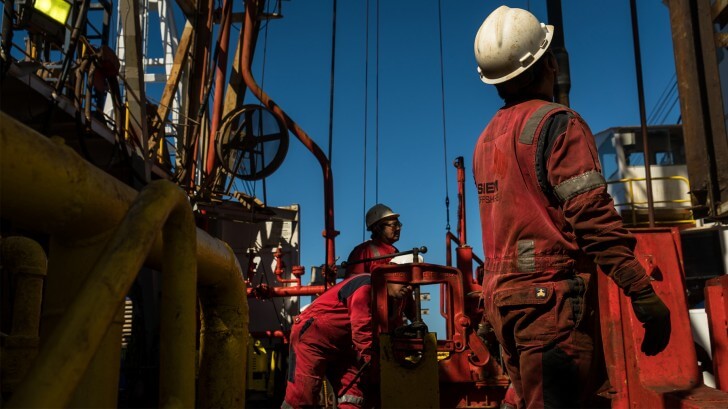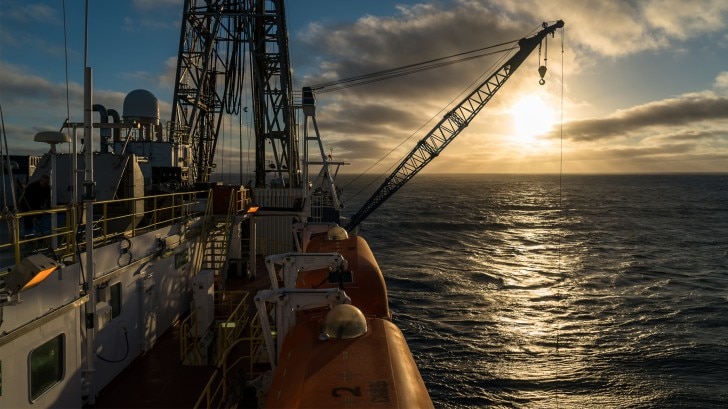BBC Earth newsletter
BBC Earth delivered direct to your inbox
Sign up to receive news, updates and exclusives from BBC Earth and related content from BBC Studios by email.
Oceans
We still know more about the surface of Mars than what’s under our own seabed.
Here we profile a scientific research vessel that has drilled more holes in the ocean floor than any other and whose expeditions continue to make some of the greatest scientific discoveries of our time.
Name: JOIDES Resolution
Nickname: JR
Operator: International Ocean Discovery Program (IODP)
Launched: 1978 (with IODP since 1985)
Type: Ocean-going research drilling vessel
Height: 62m (similar to the leaning tower of Pisa)
Crew: 70 + 60 scientists and technicians
The JOIDES Resolution (JR for short) circumnavigates the globe drilling holes and pulling up rock cores from under the seabed all in the name of scientific research. Rock cores hold important clues to our planet’s past and future and the JR provides the perfect place to investigate some of the biggest questions about Earth.
Not only is the JR an impressive ship, it’s also a floating laboratory that scientists use to analyse each core and tell us about the climate and life that existed when the sediments where deposited back through Earth’s history.

The JR takes its name from HMS Resolution, the vessel that took Captain James Cook on his second and third voyages to the Pacific in search of new continents. So it seems only fitting that the JOIDES Resolution is also discovering continents, if in a slightly different way. A recent expedition drilled core from the seafloor that revealed the hidden continent of Zealandia.
This is just one more in a long list of scientific discoveries made by drilling core from under the seabed. One of the first major discoveries was to confirm seafloor spreading which played a pivotal role in understanding plate tectonics.

Other major findings include; direct evidence of an asteroid impact around the time the dinosaurs went extinct 66 million years ago, salts deposits that show the Mediterranean Sea completely dried out repeatedly 5 million years ago, the discovery of abundant microbial life living deep in the in the Earth's crust, and the boat has just completed a project to install New Zealand’s first sub-seafloor earthquake monitors that will help us understand how, why and when earthquakes happen there.

JR scientific expedition stats:
Number of expeditions: 165
Total distance travelled: 538,752 nautical miles
Core holes drilled: 2500
Length of core recovered: 322,616m
Deepest hole drilled: 2111m
Deepest water depth drilled in: 5980m

2018 marks the 50th anniversary of scientific ocean drilling. In 1968, the Deep Sea Drilling Project was born and - though it has gone through several name changes and morphed from a solely US funded operation to an international collaboration involving 24 countries including the European Consortium for Ocean Research Drilling (ECORD) - it continues to probe unknown parts of our planet.
Since 2013, it has been known as the International Ocean Discovery Program (IODP). Dr Kara Bogus, an expedition project manager for IODP explains; “You can learn a lot about the Earth with ocean drilling. The drilling programmes are now the longest running and arguably most successful of the geoscience international collaborations. We have been to every major ocean basin multiple times. The Earth is mostly covered by ocean, but what we are looking at is still only a tiny fraction.”

Dr Brian Huber from the Smithsonian Museum of Natural History has sailed on the JR for three expeditions.
“We’re on a vessel that can go almost anywhere in the world's oceans and can core ocean sediments in almost any water depth, getting all kinds of Earth history records. We may discover some big extinction event or climate change, but I think what's been most important in the last few decades is just providing a very detailed record from around the globe unfolding a really detailed story about the evolution of life, of the oceans and of the continents.” he says.
Dr Vivien Cumming is a writer, photographer and filmmaker specialising in documenting scientific expeditions. You can find more of her work on her website www.viviencumming.com or follow her on instagram and twitter: @drvivcumming
Featured image © Vivien Cumming